Abstract
In this study, a dendrite-reinforced Mg-based amorphous alloy composite was prepared through an in situ precipitation strategy. After plasma electrolytic oxidation (PEO) treatment, the Mg85.1Zn12.7Ca2Cu0.2 amorphous alloy composite exhibited enhanced plasticity and corrosion resistance in a simulated body fluid solution (SBF). The PEO-treated composite showed a significant plastic strain of 10.5 ± 1.1%, as well as outstanding strain-hardening behavior. The enhancement of plasticity may be attributed to the in-situ formed coating, which can not only serve as a propagation barrier for shear bands but can also introduce nucleation sites in the bands as a result of stress mismatch and compositional heterogeneity. The corrosion density in the SBF decreased by three orders compared with the composite substrate. The spontaneous formation of apatite on the porous layer demonstrated that the prepared PEO coating has high bioactivity. The current work may provide a fundamental basis for developing biomedical Mg-based alloys with excellent comprehensive mechanical properties and corrosion resistance.
1. Introduction
In recent years, Mg and its alloys have attracted increasing attention as metallic implants owing to their good biodegradability, biocompatibility and elastic modulus similar to natural bone [1,2,3]. Despite their various advantages, these materials face several challenging obstructions in that they usually present humble mechanical strength and a rapid corrosion rate. The insufficient mechanical strength impedes their usage, as implants’ strength progressively deteriorates over the course of the degradation process [4]. The inferior corrosion resistance not only ruins their mechanical integrity over the post-implantation healing period but also results in the occurrence of hydrogen, which delays recovery at the surgery area as well as causing damage to surrounding tissues [5].
Numerous approaches have been used over the years in an attempt to promote the bio-corrosion resistance and strength of Mg alloys, including coatings, surface modifications and alloying [3,6]. Recently, amorphous alloys have attracted increasing attention owing to their large hardness, high strength and excellent corrosion resistance, which make them a promising candidate for many functional and structural applications, including sporting goods, electronics, biomaterials and aerospace devices [7,8,9,10,11]. Unfortunately, deformation in monolithic amorphous alloys is generally localized within shear bands that may instantly propagate across the whole specimen due to strain softening and/or thermal softening, which leads to final catastrophic fractures. To surmount this critical shortcoming, many efforts have been made in the design of composite structures consisting of an amorphous matrix and a second ductile crystalline phase [12,13]. However, compared with monolithic Mg-based amorphous alloys, the corrosion resistance of such composites is inevitably reduced since the interface between the crystalline phase and the glassy matrix often serves as the core of pitting corrosion [14].
It has been demonstrated that plasma electrolytic oxidation (PEO) is a feasible way to improve the corrosion resistance of Mg alloys, which can impel porous and strongly adherent ceramic coatings to be generated on the surface of the substrate [15,16]. Importantly, the thickness, constituted phase and chemical component of the films can be readily mediated by selecting dissimilar electrolytes or tuning electrical parameters. In this study, a ductile Mg-based amorphous alloy composite containing a small amount of the antibacterial element Cu was successfully prepared as a substrate for PEO treatment. The coated composite exhibited an unusual combination of high strength, large ductility and excellent bio-corrosion resistance.
2. Materials and Methods
2.1. Fabrication and Characterization of Amorphous alloy Composite Specimens
Alloy ingots with a nominal composition of Mg85.1Zn12.7Ca2Cu0.2 (at. %) were prepared by induction melting elemental Mg, Zn, Ca and Cu (purity of 99.99%) under an Ar atmosphere. The prepared alloy ingots were remelted 3 times to confirm chemical uniformity. From the smashed alloy ingots, cylindrical specimens with a radius of 2 mm and length of 50 mm were obtained by copper-mold injection casting with an overpressure of ~100 kPa.
Sample characterization started with structural analysis by X-ray diffraction (XRD, D8 Advance, Bruker, Billerica, MA, USA) with a Cu-Kα radiation source (λ = 0.15418 nm) at 40 kV and 15 mA, employing a scanning rate of 0.05 °/s in a 2θ ranging from 20° to 80°. For the bulk specimens, the as-cast rod alloys were directly grinded into plates for XRD analysis. The PEO coatings were also prepared on the grinded plate specimens for XRD analysis. Phase characterization of the cast specimens was carried out by high-resolution transmission electron microscopy (HRTEM, Tecnai G2 F30, FEI, Hillsboro, OR, USA) and energy-dispersive spectroscopy (EDS) attached to scanning electron microscopy (SEM, SU-70, Hitachi, Tokyo, Japan).
2.2. Fabrication and Characterization of PEO-Treated Specimens
Before the PEO treatment, all samples were burnished with 2000-grit abrasive papers, degreased with acetone, thoroughly rinsed with distilled water and, finally, naturally cooled. The PEO treatment was operated with a pulse power supply, with the pre-sample as the anode, and a stainless-steel container as the cathode electrode. The electrolyte used in the process was an aqueous solution of Ca(H2PO4)210 g/L, NH4HF2 14 g/L, C3H8O3 5 g/L and KOH 3 g/L. During the PEO treatment, the applied voltage, pulse frequency and duty ratio were fixed at 300 V, 200 Hz and 40%, respectively. Then, the samples were handled for 10 min, and the electrolyte temperature was controlled below 15 °C.
XRD, HRTEM and SEM/EDS were utilized to confirm the microstructure of the PEO coating. Specimens with an aspect ratio of 2:1 were cut from the as-cast and PEO-treated rods, and the two ends were carefully polished. The yield stress, fracture strength, Young’s modulus and plastic strain were characterized by an Instron 5982 testing machine at a strain rate of 2 × 10−4 s−1. The fracture photos were observed by SEM. Potentiodynamic polarization tests were carried out in a simulated body fluid (SBF) solution using a three-electrode electrochemical cell. The apatite-forming ability of the PEO-treated alloy was evaluated by soaking the alloy in SBF. The specimens were immersed in a vertical manner in the SBF solution in a plastic container at 37 °C for 3 and 7 days. The surface morphologies of the PEO-treated specimens after being soaked in SBF solution were analyzed by SEM. The surface functional groups of the specimen after immersion were detected by a Fourier transform infrared spectrometer (FT-IR, Nicolet 6700, Thermo Fisher Scientific, Waltham, MA, USA).
3. Results and Discussion
Figure 1a shows the cross-sectional microstructure of an as-cast Mg85.1Zn12.7Ca2Cu0.2 alloy rod with a diameter of 2 mm. It is observable that the crystalline phase with a dendritic morphology (black contrast) is homogeneously dispersed in a featureless matrix (gray contrast). The volume fraction of the dendrites is approximately 70.4% based on the area analysis from the SEM images. The diameter of the primary dendrites is 1~2 μm. The energy-dispersive X-ray spectroscope (EDS) measurements indicate that the average chemical compositions of the dendritic phase and gray phase are Mg90.5Zn8.3Ca1.2 (at. %) and Mg62.6Zn33.9Ca3.5 (at. %), respectively. The XRD pattern shown in Figure 1b indicates that all of the sharp Bragg peaks resulted from the α-Mg solid solution. Combined with the analysis dates of XRD and SEM/EDS, the dendrites in the as-cast alloy were confirmed to be α-Mg solid solution. However, no distinct characteristic peaks corresponding to the gray phase can be found within the resolution of XRD.
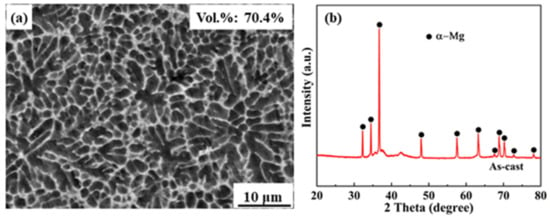
Figure 1.
(a) SEM image of the microstructure and (b) XRD pattern of an as-cast Mg85.1Zn12.7Ca2Cu0.2 alloy rod with a diameter of 2 mm.
HRTEM was further employed to ascertain the detailed structure of the as-cast Mg85.1Zn12.7Ca2Cu0.2 alloy. A bright-field HRTEM image at low magnification is displayed in Figure 2a. It can be seen that the dendrites with a bright contrast distribute in the dark contrast regions. At a high magnification, the lattice patterns dominate the interior of the dendrites (right side of Figure 2b), with the spacing of the (102) crystal plane being 0.197 nm. The left-side image shows a primarily isotropic maze pattern, which is a typical characteristic of an amorphous structure. The fast Fourier transformation (FFT)-filtered image (the inset of Figure 2b obtained from the square area marked by yellow in Figure 2b) proves the formation of an amorphous phase in the as-cast rod alloy. It should be noted that a few nanocrystals were occasionally found to be embedded in the amorphous phase (yellow ellipses).The element distribution was analyzed using EDS elemental mapping. Figure 2c,d show the local region of the amorphous alloy composite and the corresponding overall EDS mapping results of primary elements (Mg, Zn and Ca), respectively. It can be seen from Figure 2e that the dendrite phase is predominantly composed of Mg atoms. On the other hand, the Zn and Ca atoms mainly distribute in an amorphous matrix, as shown in Figure 2f,g. These results are in line with the SEM/EDS measurements. By substituting solute constituents (Zn and Ca) with more Mg atoms, the Mg85.1Zn12.7Ca2Cu0.2 alloy is virtually hypoeutectic in its chemical composition [17]. Previous studies suggested that an α-Mg solid solution can be readily formed owing to a strong thermodynamic driving force and rapid formation kinetics in the hypoeutectic compositions [18,19]. As a consequence, the α-Mg solid solution would preferentially solidify from the melt. Zn and Ca possess restricted solubility, even at high temperatures in the equilibrium. It is expected that Mg would partition to the remaining liquid in the course of the initial stage of solidification, and thus the remaining supercooled liquid would be enriched in Zn and Ca. Once the remaining supercooled liquid is close to the eutectic glass-forming composition, a glassy phase is then formed in the remaining liquid. Thus, in the current study, the in situ formed Mg-based amorphous alloy composite was successfully prepared by copper-mold rapid solidification.
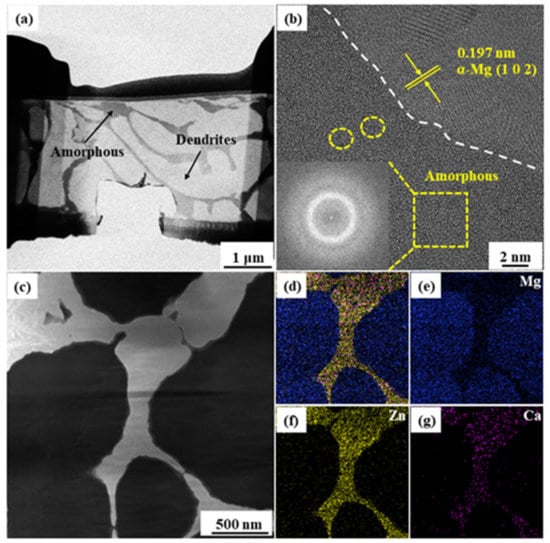
Figure 2.
(a) Low- and (b) high-magnification HRTEM images of an as-cast Mg85.1Zn12.7Ca2Cu0.2 amorphous alloy composite; (c) local region of the composite and (d–g) the corresponding EDS element mapping results.
The surface morphology of a PEO-treated Mg85.1Zn12.7Ca2Cu0.2 amorphous alloy composite specimen is presented in Figure 3a. The figure shows that the PEO coating displays a typical rough and micro-porous structure, in which independent as well as disconnected pores of different sizes distribute homogeneously over the coating surface. Most of the pores have a diameter of 2~8 μm. In addition, some nano-sized pores are also found at high magnifications (not shown here). It is suggested that such porous structures are beneficial for cellular adhesion and reproduction in the implant materials once they are implanted into the body [20,21]. The inset of Figure 3a exhibits the cross-sectional micrograph of the PEO-treated amorphous alloy composite. The PEO coating with an average thickness of 32.4 ± 2.0 μm is firmly adhered to the substrate without any obvious microcracking. To obtain the element constitution of the coating, EDS measurements were performed, and the analyses are displayed in Figure 3b. The element constitution on the surface consists of O, F, Mg, Zn and a small amount of Ca and P, as shown in Table 1. The EDS analyses imply that the electrolyte elements and amorphous alloy composites are both introduced to the ceramic coating during PEO treatment. The XRD results of a sample with a PEO coating are shown in Figure 3c. The visible XRD peaks detected on the as-received coating are ascribed to MgO, ZnO and MgF2. Although Ca and P can be detected from the EDS spectrum, there is no corresponding phase that can be examined as a result of the low contents. Figure 3d schematically illustrates the formation process of the PEO coating on the Mg85.1Zn12.7Ca2Cu0.2 amorphous alloy composite. Both Mg and Zn ions in the coating came from the dissolution of the amorphous alloy composite substrate. The dissolved Mg2+ and Zn2+ ions from the substrate migrated outward, while O2− and F−ions migrated inward to the discharge channels under the effect of an electrical field [22]. These ions reacted with each other in the discharge channels, causing the formation of MgO, ZnO and MgF2. These dense ceramic phase layers have characteristics of corrosion resistance, non-toxicity and mildness. Meanwhile, the H2O electrolysis produced a significant amount of bubbles (H2) with a slight popping sound in the electrolyte. Afterwards, a few weak acid ions (PO43−, HPO42−, H2PO4− etc.), OH− and metal cations (Mg2+, Ca2+, etc.) were slowly deposited on the oxide layer to form an outer layer (unconsolidated layer).
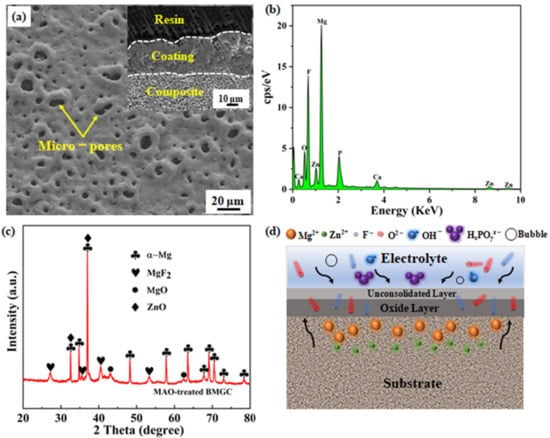
Figure 3.
(a) SEM image of the surface morphology and (b) elemental composition of the PEO coating. (c) XRD pattern of the amorphous alloy composite after PEO treatment. (d) Schematic drawing showing the formation process of the PEO coating.

Table 1.
EDS results of PEO coating.
In order to investigate whether the microstructure of the amorphous alloy composite substrate changed after PEO treatment, further HRTEM images were taken from the substrate close to the coating. At a low magnification (Figure 4a), it is observable that the dendrites with a bright contrast disperse in the dark contrast regions. At a high magnification, the lattice patterns dominate the interior of the dendrites (left side of Figure 4b), with the spacing of the (100) crystal plane being 0.277 nm. As shown on the right side of Figure 4b, the HRTEM and corresponding FFT images indicate that the dark contrast region in Figure 4a has a predominantly amorphous phase but possesses more nanocrystallites compared with the composite substrate specimen.
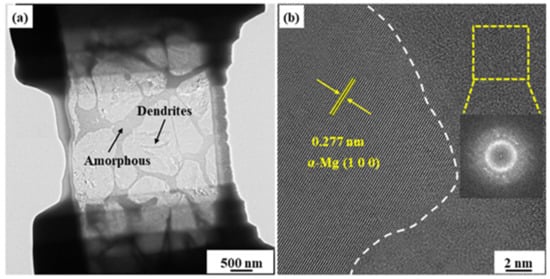
Figure 4.
(a) Low- and (b) high-magnification HRTEM images taken from the substrate close to the PEO coating.
The compressive stress–strain curves of the as-cast and PEO-treated Mg85.1Zn12.7Ca2Cu0.2 amorphous alloy composite specimens are shown in Figure 5a. The average thickness of coatings t and mechanical properties are summarized in Table 2. After yielding at an average strength of 337 ± 7 MPa, the as-cast composite specimens displayed an average plastic strain of 6.6 ± 0.7% and a high fracture strength of 589 ± 25 MPa, together with strong strain-hardening behavior. On the other hand, for the PEO-treated specimens, the average yield strength slightly decreased to 315 ± 11 MPa, but the plastic strain increased to 10.5 ± 1.1%. Furthermore, the specimens exhibited a high fracture strength of 630 ± 9 MPa and stain-hardening behavior. In addition, Young’s moduli of the as-cast and PEO-treated composite specimens were determined to be 54.6 ± 3.3 GPa and 55.9 ± 2.4 GPa, respectively, which are much smaller than those of conventional biomedical materials such as Ti alloys and stainless steel [23,24]. Figure 5b,c exhibit the SEM pictures showing the morphologies of the fracture features of the PEO-treated composite specimens. Ductile fracture dimple patterns are visible on the fracture surface in Figure 5b. Some microcrack traces terminate within dendrites, indicating that these microcracks which result from local shear banding within the amorphous phase can be effectively impeded by the dendrite phase. In addition, a vein-like pattern can also be found on the fracture surface (Figure 5c), which is the main fracture morphology for monolithic amorphous alloys [25,26,27].
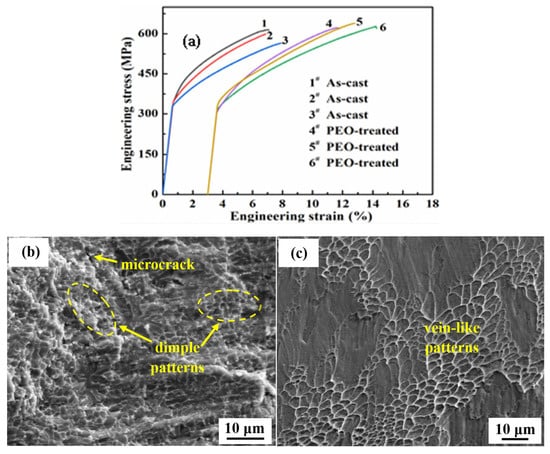
Figure 5.
(a) Compressive engineering stress–strain curves for the as-cast and PEO-treated Mg85.1Zn12.7Ca2Cu0.2 amorphous alloy composites. (b,c) Fracture morphologies of the PEO-treated composite material.

Table 2.
The average thickness of coatings t and the mechanical properties of the as-cast and PEO-treated Mg85.1Zn12.7Ca2Cu0.2amorphous alloy composite specimens, including yield stress (σy), fracture strength (σf), Young’s modulus (E) and plastic strain (εp).
In the as-cast Mg85.1Zn12.7Ca2Cu0.2 amorphous alloy composite, the soft α-Mg solid solution phase deforms first upon yielding, and plastic strain can be readily accommodated by the generation of dislocations. With increased plastic strain, a large number of dislocations would accumulate in the dendritic phase, leading to the exacerbation of lattice distortion. This, in turn, increases the resistance of dislocation motion and pins the dislocations, resulting in increased compressive strength and strong strain hardening during the course of plastic deformation. Thus, the crystal defects, i.e., pile-ups of dislocation and lattice distortion, generated in the dendrites produce strain hardening that can compensate for the strain softening of shear bands and thereby effectively suppress catastrophic failure along a single shear band, leading to the homogeneous deformation behavior of the composite material. In the coated composite specimen, the composite/coating interfaces might first become the shear transformation zones such as the nucleation sites for the shear bands due to stress mismatch. This would lead to a reduction ineffective stress necessary for band operation. It can be seen from Table 2 that the coated amorphous alloy composite has a lower apparent yield stress compared to the bare composite, revealing the presence of microyielding. For instance, local shear bands are formed at the composite/coating interfaces before the occurrence of macroyielding. If the formed bands propagate into the substrate, the bands would be stable. If the shear bands are generated inside a composite specimen and propagate outward, the coating could serve as a propagation barrier by consuming the kinetic energy of the running band via arresting or alerting their propagation route. As partial released energy could be absorbed by the coating, the driving force would decrease and the propagation of shear bands would therefore be impeded. On the other hand, the PEO processes include the reaction between the substrate elements and the electrolyte. In the course of PEO surface modification, the Mg and Zn components in the substrate primarily take part in the generation of a ceramic coating. Therefore, the composition of the inner part of the amorphous alloy composite differs from that of regions adjacent to the coating, and such compositional heterogeneity would potentially introduce more nucleation sites for shear bands. Furthermore, compared to other alloy systems (i.e., Cu-, Zr-), there are more casting defects in Mg-based amorphous alloys and their composites. The beneficial effect of the surface modification can partly be ascribed to the reduction in surface stress concentration by filling and smoothening surface scratches and pores via the in situ formation of a PEO coating. As a result, the Mg85.1Zn12.7Ca2Cu0.2 amorphous alloy composite exhibits enhanced plasticity and compressive strength via PEO surface modification treatment.
The typical potentiodynamic polarization curves of the as-cast and PEO-treated amorphous alloy composite specimens in an SBF solution open to air at 310 K are displayed in Figure 6a. The corrosion potential (Ecorr), corrosion current density (icorr) and anodic/cathodic Tafel constant (βa and βc) were obtained directly from the polarization curves by Tafel region extrapolation, and corrosion resistance (Rp) was calculated according to Equation (1) in [28]. The results are shown in Table 3.
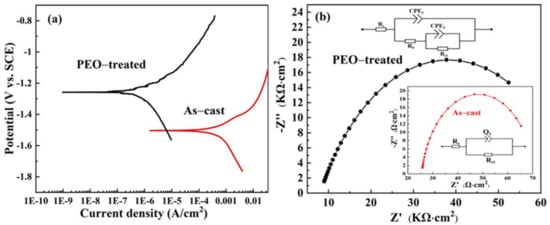
Figure 6.
(a) Polarization curves in SBF of as-cast and PEO-treated amorphous alloy composite specimens; (b) Nyquistplots of PEO-treated and as-cast specimens in an SBF solution, and their corresponding equivalent circuit model used for fitting Nyquist plots.

Table 3.
Results of potentiodynamic polarization tests in an SBF solution.
It can be seen from Figure 6a that the polarization curve for the PEO-treated amorphous alloy composite has a significant transformation regarding the area of lower current density as well as a higher potential. Compared with the bare composite, the corrosion potential of the coated specimen increases by 249 mV, and the corrosion current density decreases by three orders of magnitude, from 3.14 × 10−4 A/cm2 to 4.79 × 10−7 A/cm2. Moreover, corrosion resistance significantly increases from 1.38 × 102 Ω to 8.12 × 104 Ω. To gain a better understanding of the corrosion behaviors of as-cast and PEO-treated Mg85.1Zn12.7Ca2Cu0.2 amorphous alloy composite specimens, impedance tests were carried out in an SBF solution, and the results are shown in Figure 6b. It can be readily seen from the Nyquist plots that the PEO-treated specimen shows a larger diameter of semi-circle loops, which implies better protection against corrosive ions in an SBF solution. In addition, the impedance data determined by EIS were investigated by fitting to the equivalent circuit model presented in the inset. In the current circuit model, Rs and Rct represent the solution resistance and charge transfer resistance, respectively, and Q is the constant phase element (CPE). The fitting results of EIS spectra indicate that the Rct (45.3 Ω·cm2) of the as-cast specimen is much lower than that of the PEO-treated specimen (6.0 × 104 Ω·cm2). This finding is consistent with the results from the potentiodynamic polarization tests. Evidently, the corrosion resistance of the Mg85.1Zn12.7Ca2Cu0.2 amorphous alloy composite is greatly improved by PEO treatment, which is important in maintaining the mechanical strength of the implant in the initial bony reunion period.
Many studies have demonstrated that the essential requirement for an artificial material to combine with living bone is the generation of a bone-like apatite layer on its surface under the body environment [29,30]. In fact, this in vivo apatite can be reborn in an SBF solution, which possesses ion concentrations virtually equal to those of human blood plasma. Thus, the bioactivity of implant materials can be judged in terms of the apatite-forming ability on their surfaces in SBF. Figure 7 displays the surface morphologies of the PEO-treated amorphous alloy composite specimens after being soaked in an SBF solution for 3 and 7 days. After 3 days of soaking, the majority of small pores vanished and the sizes of big pores distinctly reduced, as seen in Figure 7a. The magnified image indicates that many spherical precipitates appeared on the surface of the PEO coating (Figure 7b). On the other hand, after being soaked in SBF for 7 days, there were almost no pores exposed on the immersed surface (Figure 7c). Additionally, the sizes of the spherical precipitates enlarged with the increased soaking time, and the precipitates gradually merged together (Figure 7d). As a result, the whole surface of the porous layer was entirely covered with precipitates after 7 days of soaking.
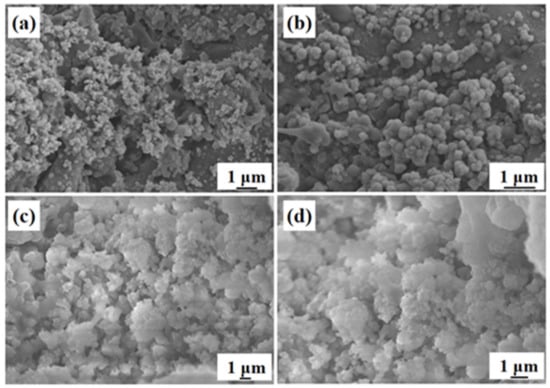
Figure 7.
Surface morphologies of the PEO-treated amorphous alloy composite specimens soaked in SBF solution for different lengths of time: (a,b) 3 days and (c,d) 7 days.
The nature of the precipitated layer was further examined by FT-IR, as shown in Figure 8. The strong broad band at 3443 cm−1 represents the stretching absorption mode of free water, and the band at 1639 cm−1 is attributed to the H-O-H bending mode of crystal water. The characteristic peak of C-O in CO32− is characterized at the absorption bands of 1460 cm−1. The peaks at 2920 cm−1 and 2851 cm−1 are assigned to H2PO4−, and the peak at 1063 cm−1 is related to the vibration of the PO43− (stretching mode) region of apatite. In combination with the results of SEM and FT-IR, it can be concluded that the prepared PEO coating on the Mg-Zn-Ca-Cu amorphous alloy composite can induce the precipitation of apatite, which is beneficial for inducing the proliferation of bone cells on an implant material and leads to good bioactivity.
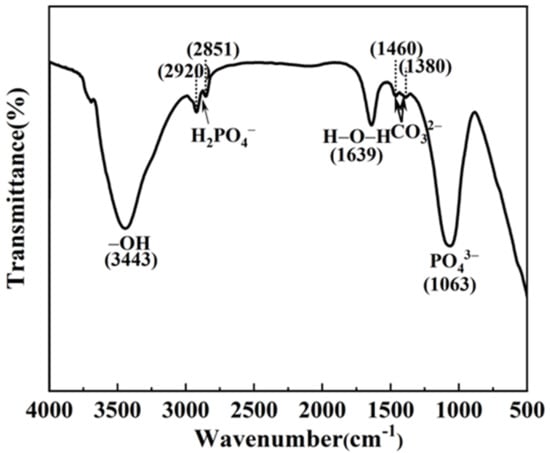
Figure 8.
The FT-IR spectrum of the PEO-treated amorphous alloy composite specimen soaked in SBF solution for 7 days.
4. Conclusions
In summary, a dendrite-reinforced Mg-based amorphous alloy composite was prepared via an in situ precipitation strategy by using copper-mold injection casting. The results of XRD, SEM and HRTEM demonstrate that the composite material consists of α-Mg solid solution dendrites and a glassy matrix. After PEO treatment, the composite exhibited an enhanced average plastic strain of 10.5 ± 1.1% and a high fracture strength of 630 ± 9 MPa, together with significant strain-hardening behavior. The improvement inplasticity may be attributed to the in situ formed coating, which can not only serve as a propagation barrier for shear bands but can also introduce nucleation sites for the bands resulting from stress mismatch and compositional heterogeneity. The corrosion density in the SBF solution decreased by three orders compared with the bare composite. The spontaneous formation of apatite on the porous layer demonstrated that the prepared PEO coating has high bioactivity. The present study provides a fundamental basis for developing high-performance biodegradable Mg alloys.
Author Contributions
Conceptualization, S.C.; methodology, Q.Z. and P.S.; validation, S.C.; formal analysis, Q.Z. and S.C.; investigation, P.S. and H.L.; writing—original draft preparation, Q.Z.; writing—review and editing, S.C. and X.Z.; supervision, S.C. and X.Z.; funding acquisition, S.C. All authors have read and agreed to the published version of the manuscript.
Funding
This research was funded by the Natural Science Foundation of Anhui Province (grant no. 1908085ME147), the International Cooperation and Exchanges in Anhui Provincial Key Project of Research (grant nos. 202004b11020010 and 1804b06020363) and the Natural Science Foundation of Anhui Provincial Education Department (grant no. KJ2020A0262). This work was also partially supported by the Open Project of Key Laboratory of Green Fabrication and Surface Technology of Advanced Metal Materials (grant no. GFST2022ZR10), and the College Students’ Innovative Entrepreneurial Training Program (S202110360179).
Data Availability Statement
The data that support the findings of this study are available from the corresponding author on request.
Acknowledgments
The authors thank J.Y., K.Q. and B.W. for technical assistance and are also grateful to I.T., W.H.L. and G.S.P. for stimulating discussions.
Conflicts of Interest
The authors declare no conflict of interest.
References
- Kiani, F.; Wen, C.; Li, Y. Prospects and strategies for magnesium alloys as biodegradable implants from crystalline to bulk metallic glasses and composites—A review. Acta Biomater. 2020, 103, 1–23. [Google Scholar] [CrossRef] [PubMed]
- Chen, Y.; Xu, Z.; Smith, C.; Sankar, J. Recent advances on the development of magnesium alloys for biodegradable implants. Acta Biomater. 2014, 10, 4561–4573. [Google Scholar] [CrossRef] [PubMed]
- Munir, K.; Lin, J.; Wen, C.; Wright, P.F.A.; Li, Y. Mechanical, corrosion, and biocompatibility properties of Mg-Zr-Sr-Sc alloys for biodegradable implant applications. Acta Biomater. 2020, 102, 493–507. [Google Scholar] [CrossRef] [PubMed]
- Witte, F. The history of biodegradable magnesium implants: A review. Acta Biomater. 2010, 6, 1680–1692. [Google Scholar] [CrossRef]
- Martinez, A.H.M.; Luthringer, B.J.C.; Feyerabend, F.; Willumeit, R. Mg and Mg alloys: How comparable are in vitro and in vivo corrosion rates? A review. Acta Biomater. 2015, 13, 16–31. [Google Scholar]
- Wang, W.; Wu, H.; Zan, R.; Sun, Y.; Blawert, C.; Zhang, S.; Ni, J.; Zheludkevich, M.L.; Zhang, X. Microstructure controls the corrosion behavior of a lean biodegradable Mg-2Zn alloy. Acta Biomater. 2020, 107, 349–361. [Google Scholar] [CrossRef]
- Zberg, B.; Uggowitzer, P.J.; Löffler, J.F. MgZnCa glasses without clinically observable hydrogen evolution for biodegradable implants. Nat. Mater. 2009, 8, 887–891. [Google Scholar] [CrossRef]
- Gu, X.N.; Zheng, Y.F.; Zhong, S.P.; Xi, T.F.; Wang, J.Q.; Wang, W.H. Corrosion of, and cellular responses to Mg-Zn-Ca bulk metallic glasses. Biomaterials 2010, 31, 1093–1103. [Google Scholar] [CrossRef]
- Li, H.; Pang, S.; Liu, Y.; Sun, L.; Liaw, P.K.; Zhang, T. Biodegradable Mg-Zn-Ca-Sr bulk metallic glasses with enhanced corrosion performance for biomedical applications. Mater. Des. 2015, 67, 9–19. [Google Scholar] [CrossRef]
- Ghidelli, M.; Orekhov, A.; Bassi, A.L.; Terraneo, G.; Djemia, P.; Abadias, G.; Nord, M.; Béché, A.; Gauquelin, N.; Verbeeck, J.; et al. Novel class of nanostructured metallic glass films with superior and tunable mechanical properties. Acta Mater. 2021, 213, 116955. [Google Scholar] [CrossRef]
- Lee, S.; Kim, S.W.; Ghidelli, M.; An, H.S.; Jang, J.; Bassi, A.L.; Lee, S.Y.; Park, J.U. Integration of transparent supercapacitors and electrodes using nanostructured metallic glass films for wirelessly rechargeable, skin heat patches. Nano Lett. 2020, 20, 4872–4881. [Google Scholar] [CrossRef] [PubMed]
- Zhang, X.L.; Chen, G.; Bauer, T. Mg-based bulk metallic glass composite with high bio-corrosion resistance and excellent mechanical properties. Intermetallics 2012, 29, 56–60. [Google Scholar] [CrossRef]
- Guo, W.; Shao, Y.; Qin, Z.; Lü, S.; Wu, S. Development of in-situ hybrid phase reinforced Mg-based metallic glass matrix composites. J. Alloy. Compd. 2020, 829, 154544. [Google Scholar] [CrossRef]
- Liu, L.; Qiu, C.L.; Zou, H.; Chan, K.C. The effect of the microalloying of Hf on the corrosion behavior of ZrCuNiAl bulk metallic glass. J. Alloy. Compd. 2005, 399, 144–148. [Google Scholar] [CrossRef]
- Nashrah, N.; Kamil, M.P.; Yoon, D.K.; Kim, Y.G.; Ko, Y.G. Formation mechanism of oxide layer on AZ31 Mg alloy subjected to micro-arc oxidation considering surface roughness. Appl. Surf. Sci. 2019, 497, 143772. [Google Scholar] [CrossRef]
- Kaseem, M.; Hussain, T.; Rehman, Z.U.; Ko, Y.G. Stabilization of AZ31 Mg alloy in sea water via dual incorporation of MgO and WO3 during micro-arc oxidation. J. Alloy. Compd. 2021, 853, 157036. [Google Scholar] [CrossRef]
- Wasiur-Rahman, S.; Medraj, M. Critical assessment and thermodynamic modeling of the binary Mg-Zn, Ca-Zn and ternary Mg-Ca-Zn systems. Intermetallics 2009, 17, 847–864. [Google Scholar] [CrossRef]
- Hui, X.; Dong, W.; Chen, G.L.; Yao, K.F. Formation, microstructure and properties of long-period order structure reinforced Mg-based bulk metallic glass composites. Acta Mater. 2007, 55, 907–920. [Google Scholar] [CrossRef]
- Gao, J.H.; Sharp, J.; Guan, D.K.; Rainforth, W.M.; Todd, I. New compositional design for creating tough metallic glass composites with excellent work hardening. Acta Mater. 2015, 86, 208–215. [Google Scholar] [CrossRef]
- Khan, S.P.; Auner, G.G.; Newaz, G.M. Influence of nanoscale surface roughness on neural cell attachment on silicon. Nanomedicine 2005, 1, 125–129. [Google Scholar] [CrossRef]
- Hussein, R.O.; Nie, X.; Northwood, D.O.; Yerokhin, A.; Matthews, A. Spectroscopic study of electrolytic plasma and discharging behaviour during the plasma electrolytic oxidation (PEO) process. J. Phys. D Appl. Phys. 2010, 43, 105203. [Google Scholar] [CrossRef]
- Zhao, L.; Cui, C.; Wang, Q.; Bu, S. Growth Characteristics and corrosion resistance of micro-arc oxidation coating on pure magnesium for biomedical applications. Corros. Sci. 2010, 52, 2228–2234. [Google Scholar] [CrossRef]
- Chui, P.F.; Jing, R.; Zhang, F.G.; Li, J.H.; Feng, T. Mechanical properties and corrosion behavior of β-type Ti-Zr-Nb-Mo alloys for biomedical application. J. Alloy. Compd. 2020, 842, 155693. [Google Scholar] [CrossRef]
- Pilliar, R.M. Modern metal processing for improved load-bearing surgical implants. Biomaterials 1991, 12, 95–100. [Google Scholar] [CrossRef]
- Chen, S.S.; Wu, J.J.; Tu, J.X.; Wang, H.R.; Xiong, X.B.; Hu, Q.; Zou, J.Z.; Zeng, X.R. Effect of plasma electrolytic oxidation treatment on the mechanical properties of a Zr–Cu–Ni–Ti–Al bulk metallic glass. Mater. Sci. Eng. A 2016, 672, 32–39. [Google Scholar] [CrossRef]
- Deng, X.D.; Chen, S.S.; Hu, Q.; Xie, S.H.; Zou, J.Z.; Sial, M.A.; Zeng, X.R. Excellent room-temperature mechanical properties in the high glass-forming Zr-Cu-Ni-Al-Nb alloy system. Mater. Res. Express 2019, 6, 086551. [Google Scholar] [CrossRef]
- Chen, S.S.; Song, P.D.; Xing, D.; Zou, J.H.; Deng, X.D.; Liu, F. Significant room-temperature plasticity in a high Zr-containing bulk glassy alloy. J. Mater. Res. 2020, 35, 1590–1597. [Google Scholar] [CrossRef]
- Stern, M.; Geary, A.L. Electrochemical polarization: I. A Theoretical analysis ofthe shape of polarization curves. J. Electrochem. Soc. 1957, 104, 55–63. [Google Scholar] [CrossRef]
- Kokubo, T. Bioactive glass ceramics: Properties and applications. Biomaterials 1991, 12, 155–163. [Google Scholar] [CrossRef]
- Kitsugi, T.; Yamamuro, T.; Nakamura, T.; Kokubo, T.; Takagi, M.; Shibuya, T.; Takeuchi, H.; Ono, M. Bonding behavior between two bioactive ceramics in vivo. J. Biomed. Mater. Res. 1987, 21, 1109–1123. [Google Scholar] [CrossRef]
Publisher’s Note: MDPI stays neutral with regard to jurisdictional claims in published maps and institutional affiliations. |
© 2022 by the authors. Licensee MDPI, Basel, Switzerland. This article is an open access article distributed under the terms and conditions of the Creative Commons Attribution (CC BY) license (https://creativecommons.org/licenses/by/4.0/).